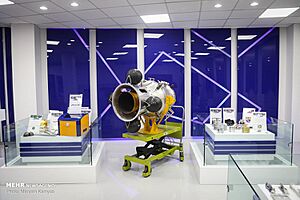Saman-1 (rocket stage) facts for kids
The Saman-1 is a special part of a rocket, like a small space vehicle, being built by the Iranian Space Research Center. Its job is to help move satellites from a lower orbit (about 400 kilometers high) to much higher orbits. Think of it as a 'space tug' that pushes satellites to their final destination in space. It was first shown to the public on February 1, 2017, by the then-president of Iran, Hassan Rouhani, during a special day celebrating space technology.
The Saman-1 can be used as a third section or a 'kick-motor' on rockets like the Simorgh launch vehicle. A 'kick-motor' gives a final push to a satellite to get it into its correct orbit. Experts also think it might be used as the third section for another rocket called the Qased, even though not much information has been officially shared about it.

Saman-1 upper-stage
|
|
| Manufacturer | Iranian Space Research Center |
|---|---|
| Country of origin | |
| Used on | Simorgh (in future) Qased (possibly) |
| General characteristics | |
| Gross mass | 240 kg (530 lb) |
| Propellant mass | 185 kg (408 lb) |
| Empty mass | 55 kg (121 lb) |
| Arash-24 | |
| Thrust | 13 kN (2,900 lbf) |
| Burn time | 40 seconds |
| Associated stages | |
| Comparable | Star 24 |
| Launch history | |
| Status | In development |
Contents
How the Saman-1 Rocket Stage Works
The Saman-1 uses a powerful engine called the Arash-24. This engine runs on solid fuel, which means it uses a solid block of fuel that burns to create thrust. The Arash-24 engine produces 1.3 tons of thrust and burns for 40 seconds.
When it's full of fuel, the Saman-1 weighs about 240 kilograms. Once all the fuel is used up, it weighs only 55 kilograms.
Moving Satellites to Higher Orbits
The main job of the Saman-1 is to move satellites from a low orbit, about 400 kilometers above Earth, to much higher orbits. It can push satellites up to 7,000 kilometers high.
For its first mission, the Saman-1 will lift a 100-kilogram satellite. It will move this satellite from a 400-kilometer circular orbit to an elliptical orbit. An elliptical orbit is shaped like an oval, not a perfect circle. The satellite will go as high as 700 kilometers and as low as 400 kilometers in this new orbit.
After the first two parts of the rocket finish their job, they release the satellite and the Saman-1 into a temporary orbit. Then, the Saman-1 takes over. It makes sure the satellite is stable and stops any wobbling. Finally, it carefully pushes the satellite into its exact target orbit.
Special Parts of Saman-1
Engineers designed many new parts just for the Saman-1. These include a special system for navigation and control, which helps it know where to go. It also has a solid-fuel engine made from light but strong titanium. Small 'cold gas thrusters' help it steer. There's also a power system and a flight computer to manage everything.
Future Plans for Saman Stages
The Saman-1 is just the first version. Future versions are planned to move satellites even higher:
- Saman-2 will be able to move satellites from 400 kilometers up to 10,000 kilometers.
- Saman-3 will go even higher, up to 21,000 kilometers.
- Saman-4 is designed to reach very high orbits, up to 36,000 kilometers. These high orbits are called geostationary or geosynchronous orbits, where satellites stay above the same spot on Earth.
History and Development of Saman-1
Work on the Saman-1 began in 2015. The first model was shown to the public on February 1, 2017, by President Hassan Rouhani.
By December 2018, a second model was being tested. In December 2019, the Arash engine, which powers the Saman-1, was successfully tested in a vacuum. This test showed it could work in space.
A test flight of the Saman-1 happened in June 2021. This was a 'suborbital' test, meaning it went into space but didn't complete a full orbit around Earth. This test was successful. Another successful suborbital test took place on October 3, 2022. The first full operational test flight of the Saman-1 system is planned for 2022–2023.
On December 6, 2024, a Simorgh SLV rocket launched a Saman-1 orbital transfer block. It reached an altitude of 400 kilometers. It also carried two other payloads, including the Fakhr-1 satellite, with a total weight of 300 kilograms.
Images for kids
See also
- Simorgh (rocket)
- Qased (rocket)
- Iranian Space Agency
- Semnan Space Center
- List of upper stages


